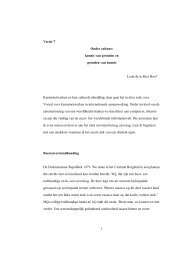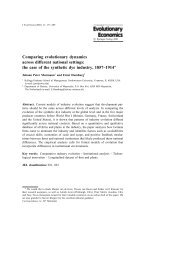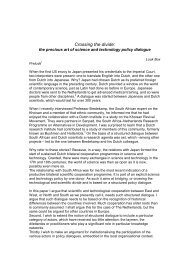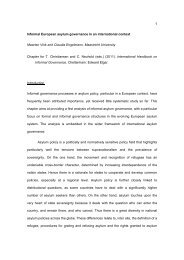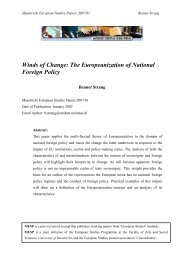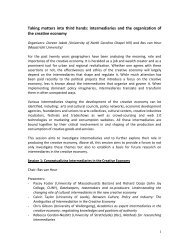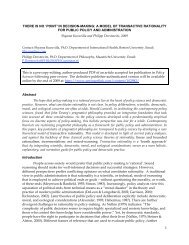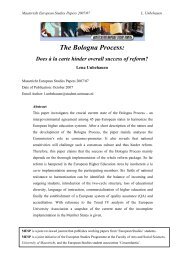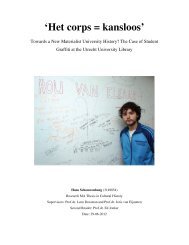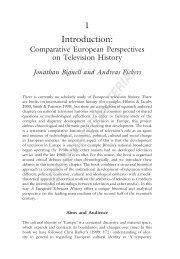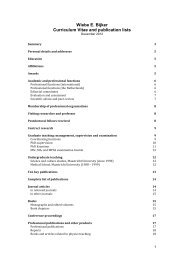About the Journal - Cities Institute
About the Journal - Cities Institute
About the Journal - Cities Institute
Create successful ePaper yourself
Turn your PDF publications into a flip-book with our unique Google optimized e-Paper software.
lies is in <strong>the</strong> general term „renewal‟ – i.e. replacing worn out or updating venues,<br />
image, economy, tourism offer etc., including repositioning „old culture‟ (heritage)<br />
for contemporary culture and entertainment - and <strong>the</strong> shift from arts and culture to<br />
<strong>the</strong> expansive creative industries (Campbell, 2011). Cultural tourism and postindustrial<br />
economics <strong>the</strong>refore drive this universal tendency, which is also fuelled by<br />
<strong>the</strong> globalisation of cultural intermediary activity - curators, architects, artistic<br />
directors - which has in turn enabled <strong>the</strong> growth of, and opportunity for cities to<br />
develop culture city strategies and festivals - at an imported price. Manifestations<br />
include <strong>the</strong> growth of biennales (over 140 worldwide) and cultural festivals, including<br />
<strong>the</strong> European and national city/capital of culture initiative, and <strong>the</strong> ubiquitous art<br />
museum.<br />
Regeneration, not just Renewal<br />
However, renewal (and <strong>the</strong> US „revitalisation‟) must be distinguished from<br />
regeneration which is more associated with extremes of social decline, multiple<br />
deprivation and disadvantage and in economic terms, below-average<br />
performance (for EU Regional Structural Fund eligibility, below 75% of <strong>the</strong> EU -<br />
average). Regeneration <strong>the</strong>refore responds to a degree of sustained degeneration,<br />
defined as <strong>the</strong> transformation of a community or place that has displayed <strong>the</strong><br />
symptoms of environmental (physical), social and/or economic decline. What has<br />
been described as: „breathing new life and vitality into an ailing community, industry<br />
and area [bringing] sustainable, long term improvements to local quality of life,<br />
including economic, social and environmental needs‟ (in Evans and Shaw, 2004).<br />
Mainstream regeneration programmes such as central government Single<br />
Regeneration Budget (SRB), New Deal for Communities (NDC) and <strong>the</strong>ir<br />
predecessors originating in <strong>the</strong> 1970s – <strong>the</strong> European Structural Development Fund<br />
(ERDF) and European Social Funding (ESF) - have traditionally lacked a cultural<br />
dimension and „culture‟ is not one of <strong>the</strong> key domains that feature in how<br />
improvement is measured and regeneration investment is assessed (Evans, 2005).<br />
Culture, however, touches <strong>the</strong> mainstream in economic terms - through creative<br />
industries and tourism sector employment, which often serve as proxies for „culture‟<br />
in economic development - and in social terms (social cohesion and capital and<br />
quality of life) and most explicitly in physical regeneration through cultural facilities,<br />
icons and public facilities, including infrastructure. Transport infrastructure - airports,<br />
bridges, light rail and metros feature highly in cities using culture as part of <strong>the</strong>ir<br />
place-making plans and have been a fundamental prerequisite in putting cultural<br />
quarters and cities on <strong>the</strong> map, for example, Bilbao, Salford Quays, Gateshead and<br />
La Defense, Paris.<br />
The distinction between <strong>the</strong> „city of renewal‟ – to which all places eventually look in<br />
order to survive economically - and <strong>the</strong> „city of regeneration‟, is <strong>the</strong>refore important<br />
when evaluating culture and regeneration policy and impacts. CoCs and Festival<br />
<strong>Cities</strong> whilst sharing some common goals display quite different rationales for<br />
„renewal and regeneration‟. For example, <strong>the</strong> small historic city of Bruges (CoC 2002)<br />
in contrast to, say, Glasgow (1990) and Liverpool‟08, or when compared with capital<br />
cities of culture such as Madrid (1992), Copenhagen, (1996), or Dublin (1991). The<br />
latter are often playing catch-up with <strong>the</strong>ir major cultural facilities, quarters and city<br />
7



